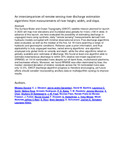Please use this identifier to cite or link to this item:
http://ir-library.mmust.ac.ke:8080/xmlui/handle/123456789/1636| Title: | An intercomparison of remote sensing river discharge estimation algorithms from measurements of river height, width, and slope. |
| Authors: | Mbiawa, Durand C. J., Gleason Garambois, pierre-andre Bjerklie, David M. Smith, Laurence C. Roux, Hélène Rodriguez, Ernesto Bates, P. D. Pavelsky, T. M. Monnier, Jerome Chen, X. Baldassarre, Giuliano Di Fiset, J.-M. Flipo, Nicolas Frasson, Renato Prata de Moraes J., Fulton Goutal, Nicole Hossain, F. Humphries, E. Minear, J. Toby Mukolwe, Micah Neal, Jeffrey C Ricci, S. Sanders, Brett Schumann, G. Schubert, Jochen E. Vilmin, Lauriane |
| Keywords: | Intercomparison, remote, sensing, river ,discharge, estimation,algorithms, measurements, river, height, width, slope. |
| Issue Date: | 13-May-2016 |
| Publisher: | Water Resources Research |
| Abstract: | The Surface Water and Ocean Topography (SWOT) satellite mission planned for launch in 2020 will map river elevations and inundated area globally for rivers >100 m wide. In advance of this launch, we here evaluated the possibility of estimating discharge in ungauged rivers using synthetic, daily "remote sensing" measurements derived from hydraulic models corrupted with minimal observational errors. Five discharge algorithms were evaluated, as well as the median of the five, for 19 rivers spanning a range of hydraulic and geomorphic conditions. Reliance upon a priori information, and thus applicability to truly ungauged reaches, varied among algorithms: one algorithm employed only global limits on velocity and depth, while the other algorithms relied on globally available prior estimates of discharge. We found at least one algorithm able to estimate instantaneous discharge to within 35% relative root-mean-squared error (RRMSE) on 14/16 nonbraided rivers despite out-of-bank flows, multichannel planforms, and backwater effects. Moreover, we found RRMSE was often dominated by bias; the median standard deviation of relative residuals across the 16 nonbraided rivers was only 12.5%. SWOT discharge algorithm progress is therefore encouraging, yet future efforts should consider incorporating ancillary data or multialgorithm synergy to improve results. |
| URI: | https://doi.org/10.1002/2015WR018434 https://agupubs.onlinelibrary.wiley.com/doi/10.1002/2015WR018434 http://r-library.mmust.ac.ke/123456789/1636 |
| Appears in Collections: | Gold Collection |
Files in This Item:
| File | Description | Size | Format | |
|---|---|---|---|---|
| An intercomparison of remote sensing river discharge estimation algorithms from measurements of river height.pdf | 207.3 kB | Adobe PDF |  View/Open |
Items in DSpace are protected by copyright, with all rights reserved, unless otherwise indicated.
